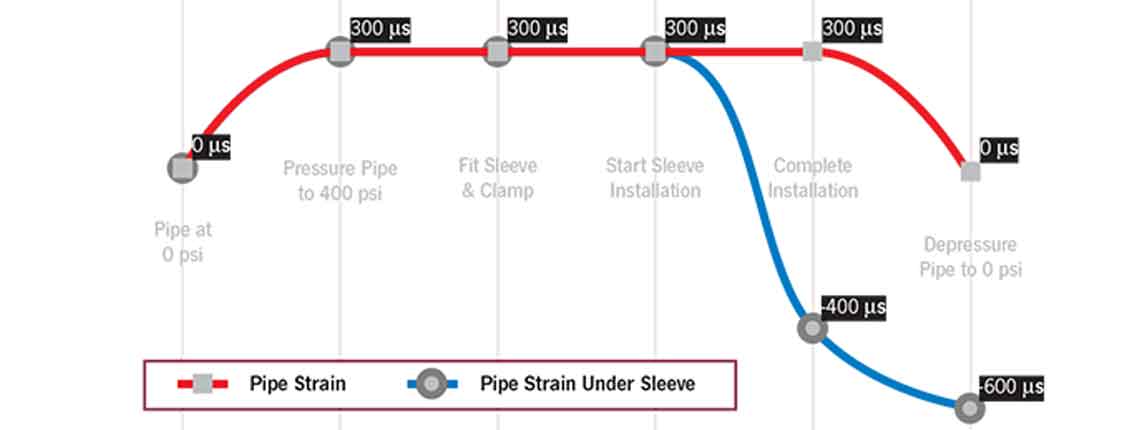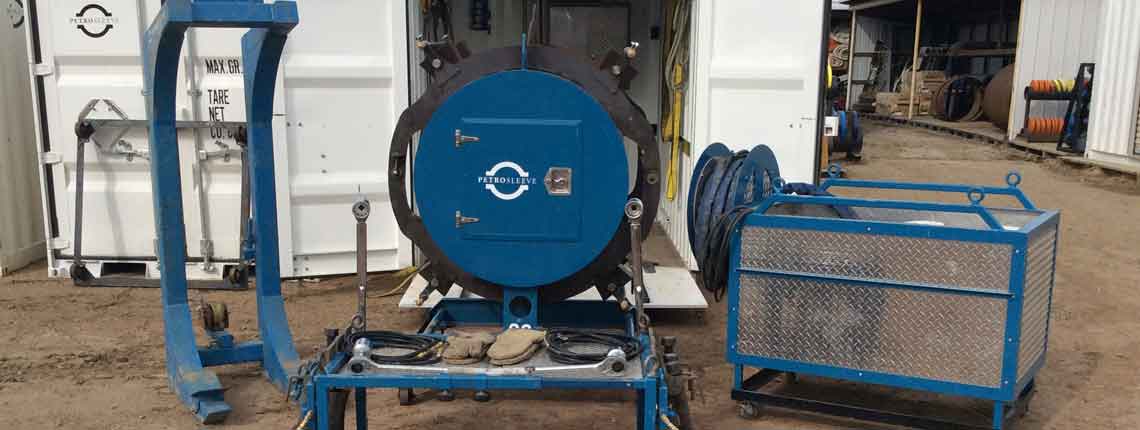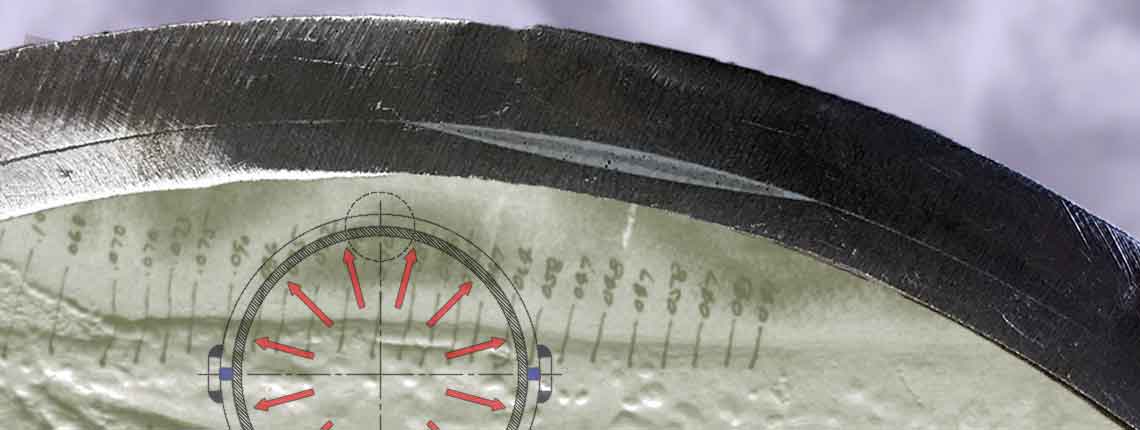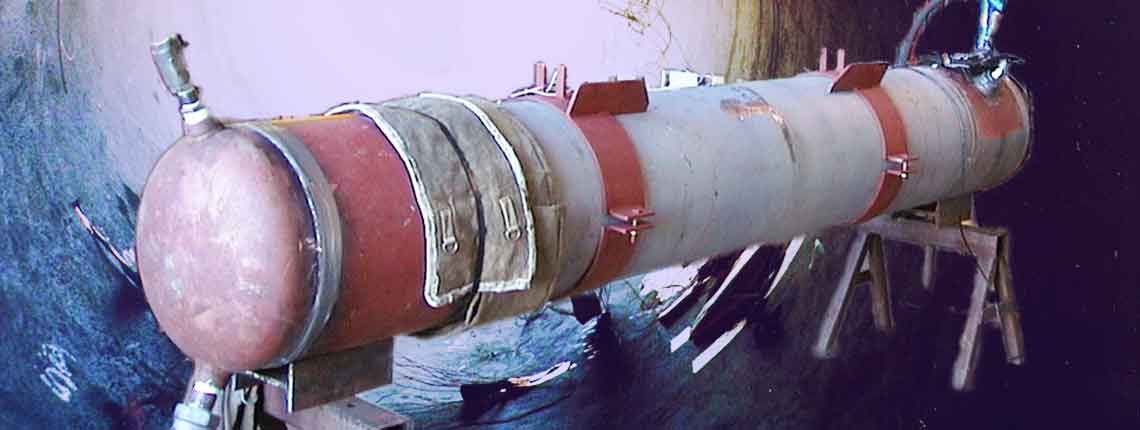Resources
For our most current and comprehensive documentation and research resourses please contact our head office. This “Resources” page offers a summary overview of that information.
News
Nisku, Alberta, June 2013
PETROSLEEVE® Epoxy Material Safety Data Sheet updates
PETROSLEEVE® Inc. has now received the updated epoxy MSDS sheets for 2013. This year, the product manufacturer did a complete MSDS analysis of the epoxy which has resulted in some significantly positive changes to the product MSDS information. Particularly, the epoxy is no longer considered dangerous goods for shipping.... ...full story (download PETRO-NEWS pdf)
Regulatory Information
- U.S. Department of Transportation (DOT)
- The U.S. Department of Transportation (DOT) has amended the regulations for repair of both gas transmission and liquid pipelines. The regulations have been changed from stating specific repair methods to a performance-based criteria.
- The performance-based phrase for dents, general corrosion, imperfections and damage, and leaks:
- “Repaired by a method that reliable engineering tests and analyses show can permanently restore the serviceability of the pipe.”
- This criterion is used in all revised sections of PART 192.
- The testing undertaken by PETROSLEEVE® illustrates the PETROSLEEVE® restrains bulging, arrests cracking, and reinforces defective pipe sections. These reliable engineering tests form the conclusion that after a PETROSLEEVE® is installed, the serviceability of the section of repaired pipe exceeds the serviceability of the adjacent pipe.
- The Department of Transportation, Research and Special Programs Administration published the following:
- 49 CFR Parts 192 and 195 [Docket No. RSPA-98-4733; Amdt. 192-88; 195-68] RIN 2137-AD25
- Pipeline Safety: Gas and Hazardous Liquid Pipeline Repair
- Sec. 192.309 Repair of steel pipe
- Sec. 192.485 Remedial measures: Transmission lines
- Please visit the U.S. Department of Transportation (DOT) for further information.
- Canadian Standards Association (CSA)
- “CSA recognizes the STEEL COMPRESSION REINFORCEMENT SLEEVE” In CSA Z662-15, the section on Steel Compression Reinforcement Repair Sleeves can be found in clause 10.11.4.4.
- In the June 2003 edition of the CSA Z662 Standard this compression repair technology was recognized as the STEEL COMPRESSION REINFORCEMENT SLEEVE Repair. The PETROSLEEVE® Pipeline Repair System meets and exceeds all the requirements of the Z662 standard.
FAQ
The PETROSLEEVE® performs by supporting and reducing the stress in the steel adjoining the defect such that the defect is arrested from growing or deteriorating.
The PETROSLEEVE® is manufactured in Canada at our manufacturing facility in Nisku, Alberta. It is easily shipped from this location throughout the world.
No. The PETROSLEEVE® is a complete system that includes both the manufactured sleeve component and the engineering and testing component that has proven the EIP installation program required to confirm and validate repair criteria and, ultimately, the post-repair validation.
The PETROSLEEVE® is installed in the USA, Canada, Mexico, Dominican Republic, Australia and in Papua New Guinea.
Over 28,000+ successful installations worldwide.
PETROSLEEVE® installations are made on (but are not limited to) steel pipelines carrying Crude Oil, Natural Gas, Sour Natural Gas, Fresh Water, Fuel Gas, HVP Products (butane, ethylene, propane, pentane, liquid ethane), LVP Products (condensate diesel fuel, gasoline, heating oil, hydrocarbon diluents, kerosene, solvents), Misc. Gases, Misc. Liquids, Oil Well Effluent, Salt Water.
Testing and finite element analysis illustrates that the compressive action of the PETROSLEEVE® extends approximately 2 inches past the edge of the sleeve. Consequently, when the sleeves are installed within 1 1/2 inches of each other, the forces developed by the two sleeves overlap and act to restrain the bare pipe between the two edges. We recommend installing each subsequent PETROSLEEVE® as close as possible to the one previously installed.
Extensive testing on the PETROSLEEVE® technology has been undertaken, including pressure cycling, compression verification, through wall defects, dents, girth weld defects, welds, and crack extension. In addition, FEA analysis in conjunction with strain gauge work has supported sleeve development.
PETROSLEEVE® installations over stress corrosion cracking and corrosion defects were removed after being exposed to extended severe field conditions. When the sleeves were removed, the pipe surface where the epoxy had been sheared by the removal process appeared bright and clean, similar to a newly sandblasted surface.
In most circumstances, there are no pressure limits for PETROSLEEVE® installation and operation. However, based on the severity of the defect being repaired, and in some cases for large diameter repairs, pressure may require reduction during installation to ensure optimal safety conditions
Yes, the PETROSLEEVE® Pipeline Repair System and installation design is a patented process with multiple patents and patents pending.
After a PETROSLEEVE® is installed, any magnetic flux leakage inspection tool will identify the sleeve. Ultrasonic inspection tools will not identity the sleeve, but will identify the repaired defect.
Prior to installing a PETROSLEEVE®, the EIP (Engineering Installation Parameters) software is utilized to determine the sleeve design and installation parameters. The sleeve/pipe/defect assembly is designed to arrest the growth or deterioration of the defect.
Part of the installation procedure is to perform and follow quality control procedures. The information obtained in this process is input into the complimentary EIP (Engineering Installation Parameters) computer software program. The EIP software then calculates the stress level in the steel under the PETROSLEEVE®, and is also able to determine the stress intensity at the crack tip (in the case of a crack or crack-like defects).
The PETROSLEEVE® delivers defect repair for Seam or Pipe Body Cracking, Corrosion, Dents, Mechanical Defects, SCC (Stress Corrosion Cracking), and Arc Burns. Although the failure mechanism varies for each defect type, the following provides a good overview of how the PETROSLEEVE® permanently removes failure mechanisms relative to each defect type: LINK TO DEFECTS
Currently, the PETROSLEEVE® is not recommended for leaking defects, active internal corrosion, or repairs on very sharp and short radius bends.
Significant cyclic pressure testing was performed in an attempt to cause fatigue cracking to extend. After 35,600 severe pressure cycles, no evidence of crack extension was identified.
Because of the compression forces between the PETROSLEEVE® and the pipe, electrical contact exists between the pipe and sleeve. Consequently, the cathodic protection impressed upon the pipeline will protect the sleeve steel.
There is NO maximum length of repair that can be completed by the PETROSLEEVE® within the minor limitations that may exist for this repair technology. The maximum length of a single manufactured PETROSLEEVE® is 36” (914mm), however, multiple sleeves can be added in subsequent fashion to repair virtually any length of defect.
When a defect is longer than a sleeve, multiple sleeves are installed. The sleeve edges are butted to each other; NOT welded together circumferentially.
The PETROSLEEVE® has been installed on many "out of round" pipes. In all cases, the installation method resulted in a compression fit with no installation difficulties with “out of roundness”.
It takes approximately 1 hour to install an average sized PETROSLEEVE®.
When the PETROSLEEVE® Pipeline Repair System is used for a pipe defect, the installation provides additional integrity to the pipe, equivalent to a heavy wall section of pipe. Because the sleeve is composed of steel, the impressed cathodic protection used to protect the pipeline also protects the PETROSLEEVE®. What type of coating is used on the PETROSLEEVE®? Any coating suitable for coating pipe can be used on a PETROSLEEVE®. When selecting an appropriate coating material for final coating, consideration should be given to ensure a proper seal at the sleeve ends and accommodating the profile between the carrier pipe and the PETROSLEEVE®.
Clause 195.416(f), Federal Register, Vol. 64, No. 239, states that a repair method shall repair the pipe "by a method that reliable engineering tests and analysis show can permanently restore the serviceability of the pipe". All the completed engineering testing and analysis shows that by reducing the stress level in the defect region below a threshold level effectively arrests defect growth or defect deterioration. The current Canadian Code accepts the compression technology for corrosion and stress concentrating type defects. In the June of 2003 edition of Z662, the Canadian Standards Association (CSA) recognized the “Steel Compression Reinforcement Sleeve” repair method. With the PETROSLEEVE® meeting and exceeding the Z662 standard criteria, the Oil & Gas Industry can permanently repair their pipelines. Prior to the June 2003 Z662 code issue, the only acceptable method to repair stress concentration type defects (i.e. cracking) was by grinding, welding on a pressure-containing sleeve, or cutting out the defect. The PETROSLEEVE® Pipeline Repair System offers pipeline owners an incredibly cost effective, safe, reliable and proven alternative! for more information, link to our PRESS page, or, download PETRO-NEWS. In CSA Z662-15, the section on Steel Compression Reinforcement Repair Sleeves can be found in clause 10.11.4.4.
Coating and backfill can be completed immediately after installation.
Installation of NPS 20 sleeves or smaller can be installed without any hoisting equipment. Depending on site conditions, it may be useful to have hoisting equipment for sleeves installed on NPS 16 – NPS 28 pipes. All installation tools and products are easily managed by hand. Larger diameters (NPS 30 and greater) require some form of hoisting equipment.
Links
Energy and Utility Boards
Energy Related Associations
Standards
Pipeline Integrity Related Information
Energy and Utility Boards
Alberta Energy and Utilities Board (AEUB)
This is the regulatory board for Canadian provincial pipelines; you will find company codes, well information and regulatory news on this site.
This is a forum for all member gas companies, as well as several others.
Canadian National Energy Board (NEB)
This is Canada’s National Energy Board (NEB). Here you will find
topics including energy overview, regulatory updates,
publications, statistics,
and safety & environment.
Energy Related Associations
This site offers global news, standards recommended practices, and various other programs.
Canadian Association of Petroleum Producers (CAPP)
Review gas prices, environmental, societal, and economic issues with this link.
Canadian Energy Pipeline Association (CEPA)
At CEPA, you can review policy, publications, newsletters, conferences, events, maps & statistics, awards, and find other valuable links.
Department of Transportation (DOT)
The U.S. DOT site delivers news, links, strategy, and programs.
National Transportation Safety Board
This site covers safety in transportation, including: Aviation, Highway, Marine, Pipeline & Hazardous material, and Railroad, publications, public hearings and “Pipeline Hearing 2000: Agenda, transcripts, videos and tool photos”
Office of Pipeline Safety (OPS)
OPS is a great place to find regulations, statistics, training, incidents, and publications.
Standards
American National Standards Institute (ANSI)
You can find standards, databases, events membership, and services information on this site.
ASME offers mechanical engineers news, events, publications, and codes information.
Canadian Standards Association (CSA)
The Canadian Standards Association is an excellent source for training, product testing, seminars, links, and industry updates.
Pipeline Integrity-Related Information
Tremco Pipeline Equipment Pty Limited
Tremco Pipeline Equipment Pty. Ltd. is an Australian owned company based in Brisbane, servicing the Pipeline equipment requirements of the Oil, Gas, Water, Mining and Petrochemical Industries within Australia, Papua New Guinea and the Pacific Islands. Tremco Pipeline Equipment Pty Limited is the PETROSLEEVE® dealer for Australian small diameter pipeline requirements.
CCT Technologies & Fitness 4 Service
This site offers information and resources on mechanical and structural integrity, remaining life assessments of pipelines, and other engineering equipment.
This is a journal covering various industry topics.
ISN Networld Software Corporation
ISN Networld is an online OQ compliance data records management and reporting tool. PETROSLEEVE® is a data provider to ISN Networld.
Petro-Line is an associated company with PETROSLEEVE® that offers expertise in Pipeline Integrity, Inspection, & Construction.
Publications
- Repairing Long Seam Cracking in the ERW Seam Welds of 1950 Vintage Pipe Using the PETROSLEEVE® Technology
- Author: R.J. Smyth, P.Eng.
- Conference: 6th Congress y Expo, de 2001 Mérida
- Location: Mérida, Yucatan, México
- Date: November 14-16, 2001
- Evaluation And Use of a Steel Compression Sleeve to Repair Longitudinal Seam-Weld Defects
- Authors: Michiel P. Brongers, Clifford J. Maier, Carl E. Jaske, Ph.D, PE, Patrick H. Vieth, Mark D. Wright, P. Eng., Robert J. Smyth, P. Eng.
- Conference: 52nd Annual Pipeline Conference
- Location: San Antonio, Texas, USA
- Date: April 17-18, 2001
- Presentation to the Banff/2001 Pipeline Workshop
- Authors: J. Kyle Keith, P. Eng., Robert J. Smyth, P. Eng.
- Conference: Banff/2001 Pipeline Workshop
- Location: Banff, Alberta, Canada
- Date: April 9-12, 2001
- Pressure Cyclic Testing The PETROSLEEVE® to Measure Edge Effects and to Illustrate the Ability of the Sleeve to Prevent Serious Pipe Defects from Failing
- Author: R. J. Smyth, P. Eng.
- Conference: 5th Congress y Expo
- Location: Morelia, Michoacán, México
- Date: October 18-20, 2000
- Repairing Pipe Defects (Stress Corrosion Cracking, Dents, Corrosion, Mill Defects) Without Operational Outages Using the PETROSLEEVE® Repair Technique
- Authors: Robert J. Smyth, P. Eng., Ing. Ruben Pavon Leal
- Conference: 4th Congreso y Expo Internacional de Ductos
- Location: Mérida, Yucatan, México
- Date: November 14-16, 2001
- Repairing Pipe Defects Without Operational Outages Using the PETROSLEEVE® Preloading Repair Technique
- Authors: Robert J. Smyth, P. Eng.
- Conference: NACE International Conference
- Location: Calgary, Alberta, Canada
- Date: December 1, 1998
- Repairing Pipe Defects (Cracking, Arc Burns, Corrosion, Dents) Without Operational Outages Using the PETROSLEEVE® Compression Sleeve Repair Technique
- Authors: Robert J. Smyth, P. Eng.
- Conference: ASME International Pipeline Conference
- Location: Calgary, Alberta, Canada
- Date: 1998





